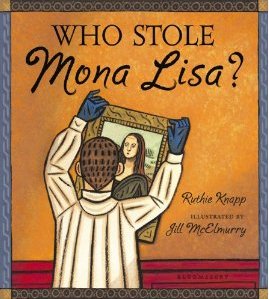Who stole Mona Lisa? by Ruthie Knapp

Ill. by Jill McElmurry. Bloomsbury, 2011. ISBN 978408511580.
(Ages 7+) Picture book. Warmly recommended. The story of the theft of
the Mona Lisa in 1911 is retold in this vibrant picture book in
celebration of the anniversary of its theft. Celebrate is probably the
wrong word to use when dealing with the theft of such a significant
painting, but the book serves to celebrate the painting itself and the
artist who painted it. The book also serves to remind us of the
fragility of such icons of our civilisation and their vulnerability.
The reader is invited into the gallery of the Louvre in Paris to look
at the painting and hear what the guide has to say. In this way the
reader is given a potted history of who the sitter was, something about
Leonardo da Vinci and why the painting was executed. Some of this
children may know but for younger readers, the facts are fascinating.
The story of what happened after Leonardo died is even more entrancing
as the painting made its way around Europe, ending up in Napoleon's
bedroom. He gave the painting to the Louvre and there it became world
famous with many visitors.
One visitor was Vincenzo Perugia, who firstly measured the painting
before stealing it in 1911. An Italian house painter, he claimed to
have stolen it to return it to Italy, but he painting languished under
his stove in his flat for two years before he was caught and sent to
prison.
A fascinating story told in part by the painting itself, the book will
encourage an interest in this painting, which draws huge crowds to the
Louvre every year. Readers will love to read of the theft and why
Perugia stole the painting and what happened to it while it was
missing. An astute teacher will use this book to encourage students to
look more closely at this well known painting, at the painter and take
a wider perspective of museums and art galleries, and perhaps other
famous thefts.
Fran Knight